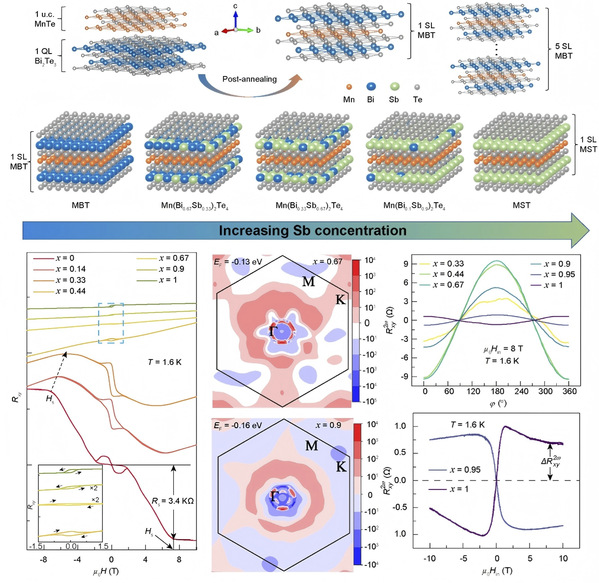In today’s world of big data, our phones and computers need to be faster and use less power. Scientists have found a way to connect electrical and magnetic signals in a special material, opening the door to new types of energy-efficient devices. Recently, a team led by Professor Kou Xufeng from the School of Information Science and Technology (SIST) at ShanghaiTech University, together with researchers from the University of Science and Technology of China (USTC), and the University of Oxford, made a major advancement in studying a unique material. Their findings were published in the journal Science Advances under the title “Tunable Chiral Magneto-Transport through Band Structure Engineering in Magnetic Topological Insulators Mn(Bi1-xSbx)2Te4.”
The material, called Mn(Bi1-xSbx)2Te4, is a “magnetic topological insulator.” Think of it as a special material that can carry electrical signals and “remember” magnetic signals at the same time. This makes it perfect for exploring ways to create faster, low-power electronics. Using a high-precision technique called molecular beam epitaxy, the team created large, high-quality thin films of this material and tweaked its properties by adjusting the amount of antimony (a metal element) inside it.
The researchers discovered that changing the antimony content is like “reprogramming” the material’s internal structure. When the antimony level is low, the material is in a special state called a “non-trivial topological state,” where electrons zip along the surface in a super-efficient “fast lane,” carrying electrical signals smoothly and resisting disruptions. As more antimony is added, the material undergoes a topological phase transition, switching to a normal state where this fast lane disappears, and the electrical signals behave more like those in ordinary materials. This change also flips the direction of the anomalous Hall conductance (AHC), a measure of how electrical signals respond to magnetic fields—for example, shifting from “left” to “right.” Additionally, the material’s spin texture—the way tiny magnetic directions are arranged—changes, creating a unique electrical signal known as the second-harmonic response. This ability to “reprogram” the material’s behavior could lead to new, ultra-low-power devices, like memory chips or parts for quantum computers.
ShanghaiTech University is the first affiliation of the study. Doctoral student Chen Peng and master’s student Huang Puyang from Prof. Kou’s group, and Li Zeyu from USTC are the co-first authors. Professors Kou Xufeng, Qiao Zhenhua from USTC, and Thorsten Hesjedal from Oxford are the co-corresponding authors.

By adjusting the mix of antimony and bismuth, scientists can fine-tune how electrons move inside the Mn(Bi1-xSbx)2Te4 material and control its anomalous Hall effect.

